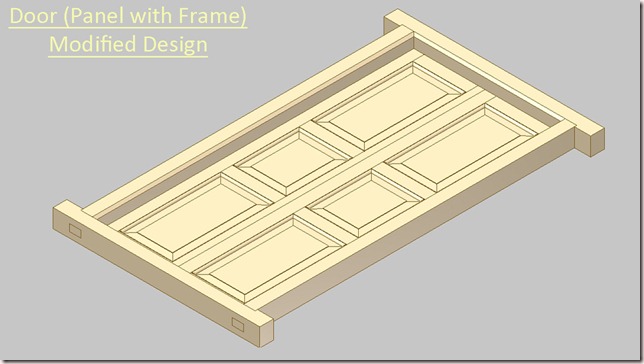Serial No. 208
Door (Panel with Frame) modified design--Autodesk Inventor 2013 (with caption)
This video tutorial features the designing process of a Door (Panel with Frame) with the aid of Autodesk Inventor's part and assembly modelling functionality. Here we have added some more feature i.e., design of rounded beading, cutting of rectangular slots around the Frame of Panel in our previously created model. The highlight of the video is application of 'Copy Components' feature that is quite a time saving utility available in the Assembly modeling environment.
Click the following link to get the model file: - http://bit.ly/2nHK1w6
Transcription of Video
- Create a new assembly file with an English template.
- Place the Part 1 and Part 2 in the assembly.
- Apply constraints between Part1 and Part2 to position properly according to the design of the frame.
- Two more instances of the Part1 and Part 2 are required, so use the Copy components command to duplicate these parts.
- Activate the Copy Components command.
- Select the Part1 file to create its copy.
- Take a look on this green status button which is active by default, it means a copy of the component would be created that would not be associative to the source file.
- Click Next button.
- Click OK to generate the new component.
- Unground the Part1_CPY to apply the constraints.
- Rotate the component to position properly for applying new mates.
- Apply Mate and Flush constraints between Part1_CPY and Part2, so that the parts may fit with each other without any obstacle.
- Check the interface between Part1 and Part2.
- Also create a copy of Part2.
- Apply the mates as shown earlier.
- Now the assembly is complete.
- Save the file with the name Subassembly-1 and close it.
- Open the Part3 file from the Subassembly-2 folder.
- Draw a new sketch on this face to create the beadings with the aid of Project Cut Edges command and Arc tool.
- Activate the Extrude command and select Cut option to remove the extra material.
- Activate the Mirror Tool and select the Extrusion43 feature from the browser bar.
- Define the XZ plane of the model as a mirroring plane and execute the command.
- Create a Work Plane at a defined angle with respect to this edge.
- Start a new sketch over this Plane.
- Use Project Cut Edges command to convert the intersecting edges of the model as sketches.
- Exit the sketch and activate the Extrude command with Cut option to remove the excess material from the model.
- Remove the material from this face as done earlier.
- Repeat the same type of operations which were done earlier.
- Mirror these three features by using the mid plane of the model.
- Create a new work plane on this point perpendicular to this edge.
- Create another work plane at an offset distance of 1/16 inch from this work plane and close its visibility.
- Create a new sketch on the Work Plane30.
- Use Project Cut Edges command to get the model edges.
- Draw a rectangle with the given dimensions.
- Exit from the 2D sketch.
- Activate the Extrude command with Cut option to create rectangular slots around the rounded beading.
- Mirror these extrude features to complete the file.
- Save the Part3 file and close it.
- Open the Part4 file.
- Draw a new sketch on this face to create the beadings with the aid of Project Cut Edges command and Arc tool.
- Activate the Extrude command and select Cut option to remove the extra material.
- Activate the Mirror Tool and select the Extrusion25 feature from the browser bar.
- Define the XZ plane of the model as a mirroring plane and execute the command.
- Create a new work Axis by using these two points.
- Create a Plane at a defined angle with respect to this axis.
- Start a new sketch over this Plane.
- Use Project Cut Edges command to convert the intersecting edges of the model as sketches.
- Exit from the sketch and activate the Extrude command with Cut option to remove the excess material from the model.
- Mirror the Extrusion26 feature by using XY plane of the model.
- Create a new sketch over the front face of the model.
- Use Project Cut Edges command to get the model edges.
- Draw a rectangle with the given dimensions.
- Exit from the 2D sketch.
- Activate the Extrude command with Cut option for making slot over the beading.
- Mirror the cut feature by using XZ Plane of the model.
- Save the Part4 file and close it.
- Open the Part5 file.
- Repeat the same process as done earlier in the Part4.
- Now the model is complete.
- Save the Part5 file and close it.
- Create a new assembly file with an English template.
- Place the Part3 and Part4 files respectively by using Place Component tool.
- Apply the Mate and Flush constraints between these two components to fix it according to the design of Door Panel.
- Check the interface between these components.
- Place the Part5 file.
- Fix it in the same way as the Part4 was fixed with Part 3.
- Place another instance of the Part4 in the assembly by using Copy Component tool.
- Fix the Part4_CPY into the groove of Part3 by using mates.
- In the same way, place second instances of Part5 and Part3 and fix them to complete the frame.
- Place the Part9 component in this assembly and fix it inside groove of the frame.
- Place one more instance of Part9 in the assembly and fix it tending towards its completion.
- Place Part10 component in the assembly and fix it by applying mates.
- Check the interface between Part10 and Part3.
- Save the assembly with the name Subassembly-2.
- Create a new assembly with an English template.
- Place the Subassembly-2 file.
- Copy this subassembly by using Copy Component tool.
- Change the name of the newly created subassembly as subassembly-3.
- Utilize the ‘User Path’ option to define a new save location for Subassembly-3 along with its related components.
- Fix these components by applying Mate and Flush constraints between them.
- Save the assembly with the name ‘Subassembly of frame with Panel’.
- Cut the taper locking slot on the frame as shown.
- First create sketch and apply Extrude feature with cut option.
- Remove the extra material from this part also.
- Repeat the same steps for the remaining parts too.
- In this panel of door, perform similar type of operations as done earlier.
- Start sketching, afterwards apply Extrude feature with cut option.
- Look at the quick access tool bar, the Design Doctor indicates that there is an error in the assembly. So correct it by applying modification in an Assembly constraint.
- Open this Subassembly separately and find the mate where the problem exists.
- This constraint has gone missing, so delete this mate and apply it again.
- Return back to the assembly.
- Analyse Interface between these two subassemblies and close the file.
- Create a new assembly file and place Subassembly in this assembly.
- Now place the Subassembly of Frame with panel.
- Fix the Subassembly of Frame with Panel within the Subassembly of outer Frame of Door.
- In this mate, set the offset distance of ¼ inch to accommodate the hinges.
- Save the assembly with the name ‘Door (Panel with Frame) Modified Design’.




No comments:
Post a Comment